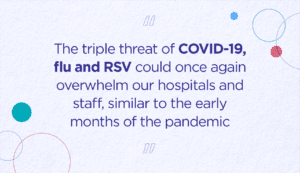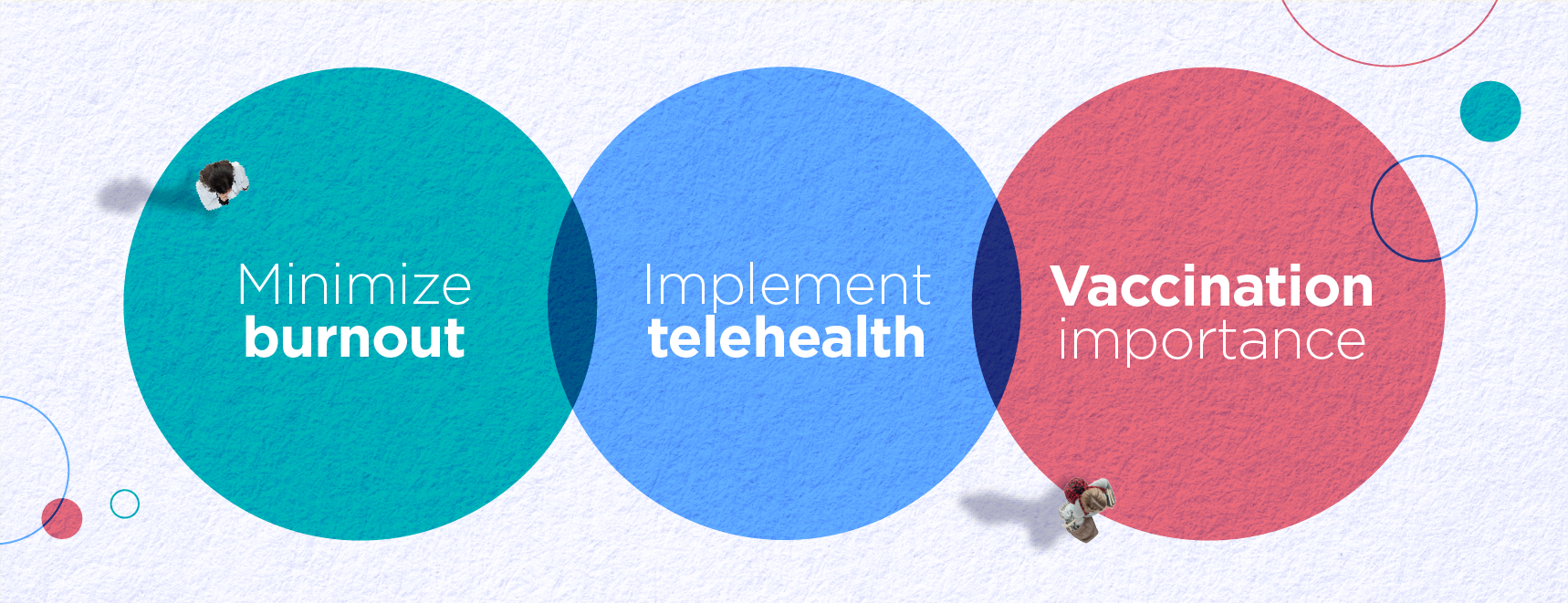Article
Preparing for the triple threat: COVID, flu and RSV
While COVID-19 ravaged the world over the last two years, another virus quietly crept into relative dormancy. Influenza, better known as the flu, recorded extremely low infection rates during the 2020–2021 flu season, with only 0.2% of specimens testing positive for the flu in the U.S. For comparison, the proportion of positive test results from the previous three flu seasons ranged from 26.6% to 30.3%.
While we can’t pinpoint the cause of this massive dip in flu cases, it’s safe to assume sanitation and self-protective measures (such as mask wearing and social distancing) that were implemented during the beginning of the pandemic played a key role. In fact, now that many countries have lifted their COVID-19 restrictions, the flu is making a massive resurgence. As of November 12, the CDC estimates that there have already been at least 4,400,000 flu illnesses, 38,000 hospitalizations and 2,100 deaths from flu in the U.S., even though we are still early in the flu season. Historically, the U.S. flu season peaks in December and January so these numbers could indicate a record-breaking flu season is on its way.
But the flu isn’t the only virus concerning the medical community in recent months. Respiratory syncytial virus (RSV), a virus that’s typically mild in adults but can turn into a severe or even deadly illness in infants, the elderly and those who are immunocompromised, has been making headlines as well. RSV began circulating in the southern U.S. over this past summer and cases are still rising as we head into the winter months—which is when RSV usually sees its largest spike in cases, similar to the flu.
Also like the flu, there was a massive drop in RSV cases over the past two years (most likely due to COVID-19 protective measures) and now the virus is surging back to the forefront with record-breaking case numbers. As for RSV’s revival, it could be a combination of relaxed COVID-19 restrictions and a lack of “primed” immune systems in infants. In other words, COVID-19 protective measures were so effective in preventing the spread of respiratory viruses that the immune systems of many infants and young children are not equipped to handle this “new” threat. Unlike the flu and COVID-19, there is currently no vaccine. As a result, pediatric ICUs across several states are already reaching maximum capacity as RSV admissions continue to rise.
 Of course, we cannot forget the continuing threat of COVID-19. In 2021 and 2022, there was a spike in cases during the winter months and scientists predict a similar trend for this year. The latest booster vaccine is bivalent, offering protection for both the original COVID-19 strain and the Omicron variants BA.4 and BA.5. However, more than 200 million Americans that are eligible have yet to receive this booster. This could be a result of vaccine fatigue or it could simply be that with the relaxation of many COVID-19 restrictions the virus no longer seems as threatening. This is a dangerous attitude, as COVID-19 remains a real threat to public health, and vaccines are still the best way to protect from severe complications and hospitalization.
Of course, we cannot forget the continuing threat of COVID-19. In 2021 and 2022, there was a spike in cases during the winter months and scientists predict a similar trend for this year. The latest booster vaccine is bivalent, offering protection for both the original COVID-19 strain and the Omicron variants BA.4 and BA.5. However, more than 200 million Americans that are eligible have yet to receive this booster. This could be a result of vaccine fatigue or it could simply be that with the relaxation of many COVID-19 restrictions the virus no longer seems as threatening. This is a dangerous attitude, as COVID-19 remains a real threat to public health, and vaccines are still the best way to protect from severe complications and hospitalization.
This triple threat (or as some are calling it, a “tridemic”) of COVID-19, flu and RSV could once again overwhelm our hospitals and staff, similar to the early months of the pandemic. While those days were a period of uncertainty, we have since learned many lessons that we can apply to the future, such as:
- Minimize provider burnout: It’s no secret that workflows in EHRs continue to be a major source of frustration for providers as they often must conform to requirements and workflows that run counter to their intuitions, experiences or clinical best practices. It takes a combination of strategies to minimize that burden. Sometimes less is more; simpler is better. By using Human-Centered Design principles, we’ve made our solutions easier to understand and easier to navigate over time. We understand that listening to end-users helps engineers and designers tremendously, and quantitative data on patterns of EHR use can be really handy for our support teams to troubleshoot and anticipate user-frustration and address it proactively. Our teams have a collective focus to reduce cognitive burden placed on providers and enable them to focus on what matters most: the patient.
- Implement telehealth whenever possible: Limiting the number of people in the care setting reduces the chances of virus transmission. Hospital at Home programs have been promoted by CMS to adequately provide care to patients outside the hospital walls to minimize contact and exposure. Dozens of virtual healthcare organizations and delivery models have sprung up in the wake of COVID-19 and are starting to extend beyond urgent care settings. We are focused on making these new models more scalable through integration between telehealth platforms and our EHRs. This has enabled telehealth providers to integrate their member applications that include messaging and scheduling, sharing of patient-reported data, and facilitation of diagnostic studies and prescription management across state lines.
- Stress the importance of vaccination: While there is no current vaccine for RSV, patients should still be encouraged to receive the annual flu shot and stay current on their COVID-19 vaccinations. For tips on overcoming vaccine hesitancy, go here.

At Altera, we are unified around the singular mission of improving patient care by supporting the teams that deliver that service. We are proud of our partnerships with health systems across the globe that have adapted the EHRs to meet the needs of their clinicians and have shared their experiences with us to disseminate across our company and clients. While I sincerely hope that the current prediction of a “tridemic” in the coming months is incorrect, I am confident that with the right strategy and tools, the healthcare community can overcome any challenge thrown its way.













